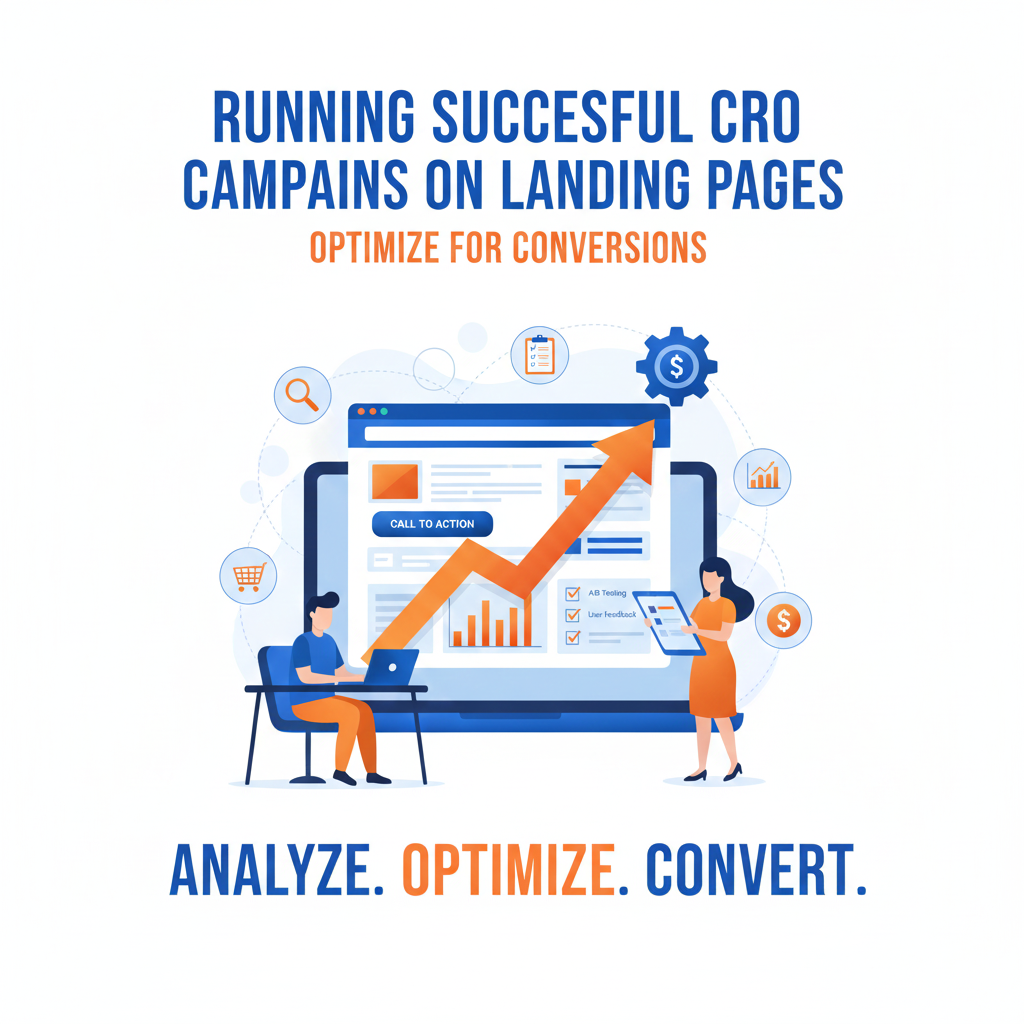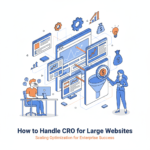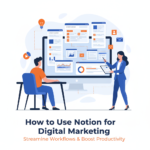
Running Successful CRO Campaigns on Landing Pages: A Complete Guide
Table of Contents
-
Introduction to CRO and Landing Pages
-
Why CRO Campaigns Are Crucial
-
Anatomy of a High-Converting Landing Page
-
Setting Clear CRO Goals and KPIs
-
Audience Research & Intent Mapping
-
Crafting a Value Proposition That Converts
-
UX & UI Design Principles for CRO
-
Persuasive Copywriting Techniques
-
Visual Hierarchy & CTAs
-
Psychological Triggers in Landing Page Design
-
A/B and Multivariate Testing
-
CRO Tools and Tech Stack
-
Mobile Optimization for CRO
-
Page Speed and Technical Optimization
-
Personalization & Dynamic Content
-
Post-Click Optimization
-
Tracking, Analytics, and Reporting
-
Common CRO Mistakes to Avoid
-
Case Studies & Success Stories
-
Final Thoughts
1. Introduction to CRO and Landing Pages
Conversion Rate Optimization (CRO) is the systematic process of increasing the percentage of users who take a desired action—sign up, buy, download, book, etc.—on your website or landing page.
A landing page is a standalone web page created for a marketing campaign with one focused goal, such as lead capture, sales, or registrations.
CRO campaigns applied to landing pages ensure that every element—design, copy, UX—is strategically aligned to drive conversions.
2. Why CRO Campaigns Are Crucial
-
Maximize ROI: You’re already spending on traffic (SEO, ads, etc.). CRO ensures you make the most of it.
-
Lower CAC: A higher conversion rate means fewer ad dollars per lead or sale.
-
Compounded Gains: A 10% increase in conversion today impacts every campaign downstream.
-
Scalability: A CRO-optimized landing page can scale quickly with paid media.
3. Anatomy of a High-Converting Landing Page
-
Headline: Clear, benefit-driven
-
Subheadline: Supportive explanation of the headline
-
Hero Image or Video: Visual context of the offer
-
Value Proposition: What’s in it for the user?
-
Call to Action (CTA): Clear, bold, and frequent
-
Social Proof: Testimonials, reviews, logos, case studies
-
Form: Short, frictionless, mobile-friendly
-
Trust Elements: Certifications, secure icons, money-back guarantees
4. Setting Clear CRO Goals and KPIs
Before any test or tweak:
-
Define macro conversions (e.g., purchases, form fills)
-
Define micro conversions (e.g., scrolls, video views, button clicks)
-
Establish a baseline: Understand your current conversion rates
-
Assign metrics like:
-
Bounce Rate
-
Time on Page
-
Form Abandonment Rate
-
Click-through Rate (CTR)
-
Return on Ad Spend (ROAS)
-
5. Audience Research & Intent Mapping
Great CRO starts with knowing:
-
Who your users are
-
What stage they are at in the funnel
-
What their pain points, goals, and objections are
Use:
-
Heatmaps (Hotjar, CrazyEgg)
-
Session recordings
-
On-page polls and surveys
-
Customer interviews
-
Google Analytics path analysis
Create Intent Maps:
-
Informational → Education-focused LPs
-
Transactional → Offer/discount-centric LPs
6. Crafting a Value Proposition That Converts
The value proposition should answer:
“Why should I choose you instead of your competitors?”
Make it:
-
Unique: Not just better, but different
-
Clear: No jargon or generic phrases
-
Visible: Place it above the fold
-
Specific: Quantify results (e.g., “Get 3x more leads in 7 days”)
7. UX & UI Design Principles for CRO
Good design isn’t pretty—it’s functional and conversion-oriented:
-
Keep it simple: One goal per page
-
Whitespace: Improves readability and focus
-
Z-pattern or F-pattern layouts: Matches eye movement
-
Consistency: Fonts, colors, and buttons
-
Visual cues: Arrows, gaze direction to point to CTAs
8. Persuasive Copywriting Techniques
Every word counts:
-
Use active voice and power words
-
Focus on benefits, not just features
-
Address objections before they arise
-
Use social proof within the copy (e.g., “Join 10,000+ subscribers”)
-
Inject urgency or scarcity (e.g., “Only 5 spots left”)
Frameworks:
-
PAS (Problem-Agitate-Solution)
-
AIDA (Attention-Interest-Desire-Action)
9. Visual Hierarchy & CTAs
-
Prioritize elements by importance
-
Use size, color, contrast, and placement to guide the eye
-
Repeat CTA buttons without being annoying
-
Use action verbs: “Start Your Free Trial”, “Book Your Demo”, “Claim Your Offer”
10. Psychological Triggers in Landing Page Design
Apply principles of behavioral psychology:
-
Reciprocity: Offer a freebie (e.g., eBook) in exchange for info
-
Authority: Mention awards, certifications, press features
-
Liking: Use relatable images and conversational tone
-
Social Proof: Reviews, counters, user-generated content
-
Loss Aversion: “Don’t miss out” vs “Get this”
11. A/B and Multivariate Testing
A/B Testing
-
Test one variable at a time (headline, image, CTA)
-
Minimum 95% statistical confidence
-
Test duration: 1–2 weeks minimum
Multivariate Testing
-
Test multiple combinations simultaneously
-
Requires higher traffic volume
Best practices:
-
Use tools like Google Optimize, VWO, Optimizely, or Convert
-
Don’t stop early
-
Segment results by device, traffic source, etc.
12. CRO Tools and Tech Stack
-
Analytics: GA4, Mixpanel, Heap
-
Testing: Optimizely, VWO, Google Optimize (sunsetting soon)
-
Heatmaps & Recordings: Hotjar, CrazyEgg
-
Surveys: Typeform, Qualaroo
-
Form Analytics: Zuko, Formisimo
-
Page Builders: Unbounce, Instapage, Leadpages
13. Mobile Optimization for CRO
-
70–80% of landing page traffic may be mobile
-
Use responsive design
-
CTA buttons should be thumb-friendly
-
Compress images for load speed
-
Reduce or hide secondary content on mobile
14. Page Speed and Technical Optimization
-
Use PageSpeed Insights or GTMetrix
-
Optimize images (WebP, compression)
-
Implement lazy loading
-
Use a fast host and CDN
-
Minimize third-party scripts
15. Personalization & Dynamic Content
-
Use user data to personalize headlines, CTAs, and images
-
Examples:
-
“Hey New York Startups, This Offer Is For You”
-
Change product recommendations based on behavior
-
-
Tools: Mutiny, RightMessage, Dynamic Yield
16. Post-Click Optimization
-
CRO doesn’t end when someone clicks the CTA:
-
Thank you pages should:
-
Reinforce value
-
Offer next steps
-
Upsell or cross-sell
-
Encourage social sharing
-
-
-
Use follow-up email automation
-
Track post-conversion behavior for further funnel optimization
17. Tracking, Analytics, and Reporting
Key tools:
-
GA4 with event-based conversion tracking
-
Tag Manager for button clicks and scroll depth
-
Looker Studio or Data Studio dashboards
-
UTM tracking to segment CRO impact by campaign/source
Important reports:
-
Funnel analysis
-
Form completion rate
-
Scroll maps
-
Device and browser performance
18. Common CRO Mistakes to Avoid
❌ Testing too many things at once
❌ Not letting tests run long enough
❌ Relying on gut, not data
❌ Ignoring mobile performance
❌ Overloading with CTAs or distractions
❌ Treating CRO as a one-time task
19. Case Studies & Success Stories
-
SaaS Landing Page: Increased conversions by 38% by reducing form fields from 7 to 3
-
eCommerce Brand: A/B tested product imagery and saw a 22% lift in sales
-
Lead Gen Agency: Added testimonials near the form and reduced CPL by 29%
20. Final Thoughts
CRO campaigns on landing pages are not about hacks or gimmicks. They are about deep user understanding, rigorous testing, and continuous optimization.
When you combine psychology, data, and design, you turn traffic into revenue. The ROI of CRO is unmatched in digital marketing when done right.
Author



